Formulation Design of Orally Disintegrating Film Using Two Cellulose Derivatives as a Blend Polymer
Abstract
1. Introduction
2. Materials and Methods
2.1. Materials
2.2. Methods
2.2.1. Film Preparation
- (a)
- HPMC was dispersed in ethanol with stirring, and then, a specified amount of distilled water was added. HPC was dissolved carefully and gradually by mixing ethanol and distilled water. To prepare the blend solution, HPMC and HPC were mixed and dispersed in ethanol, and then, distilled water was added. The solvents were mixed at an ethanol/distilled water ratio of 2:1 (w/w).
- (b)
- If necessary, the solutions were mixed with API with sufficient stirring.
- (c)
- Before casting, the film solutions/dispersions were degassed using a desiccator and a vacuum pump (ULVAC kiko, Yokohama, Japan) and kept here for more than 24 h. The films were spread on a base film (polypropylene: Pylen®; Toyobo, Osaka, Japan), fixed onto a heat-resisting glass plate using a YBA-type baker applicator (Yoshimitsu Seiki, Tokyo, Japan).
- (d)
- The films were kept in a dry chamber (KCV-4D; Advantec, Tokyo, Japan) with an air current to evaporate the solvent or water (40 °C) for more than 2 h. After drying, the defects on the surface of films were checked. They were then cut into 20 mm × 30 mm pieces, stored at room temperature for at least 24 h, and evaluated.
- (e)
- Before casting, the viscosity of HPMC/HPC blend solutions was measured using a viscometer (TV-10; Tokisangyo, Tokyo, Japan). For this measurement, the rotation speed was 60 rpm, and the type of rotor used was M2 with a guard, as described in previous studies [22]. The solutions were maintained in a water bath at 25 °C until the sample temperature reached the desired level. As shown in Table 1, the polymer (or polymer blend)/solvent ratios were 1:10 in the casting solution.
2.2.2. Mechanical Properties
- (a)
- Tensile Strength of ODFs
- (b)
- Folding Endurance (FE) of ODFs
2.2.3. Film Thickness
2.2.4. Disintegration Test
2.2.5. Differential Scanning Calorimetry (DSC) Analysis
2.2.6. Fourier Transform Infrared Spectroscopy (FTIR) Analysis
2.2.7. Morphological Observation
2.3. Statistical Analysis
3. Results and Discussion
3.1. Characteristics of the HPMC/HPC Blend Film
3.1.1. Observation of the Blend Films
3.1.2. Mechanical Properties of the Blend Films
3.1.3. Disintegration Property
3.2. Miscibility of the HPMC/HPC Blend Films
3.2.1. Differential Scanning Calorimetry
3.2.2. Fourier Transform Infrared Spectroscopy
3.3. Characteristics of the HPMC/HPC Blend Films with API
4. Conclusions
Author Contributions
Funding
Institutional Review Board Statement
Informed Consent Statement
Data Availability Statement
Acknowledgments
Conflicts of Interest
References
- Strickley, R.G. Pediatric Oral Formulations: An updated Review of Commercially Available Pediatric Oral Formulations Since 2007. J. Pharm. Sci. 2019, 108, 1335–1365. [Google Scholar] [CrossRef]
- Gupta, M.S.; Kumar, T.P.; Gowda, D.V.; Rosenholm, J.M. Orodispersible films: Conception to quality by design. Adv. Drug Deliv. Rev. 2021, 178, 113983. [Google Scholar] [CrossRef] [PubMed]
- Gupta, M.S.; Kumar, T.P.; Gowda, D.V. Orodispersible Thin Film: A new patient-centered innovation. J. Drug Del. Sci. Tech. 2020, 59, 101843. [Google Scholar] [CrossRef]
- Musazzi, U.M.; Khalid, G.M.; Sellimin, F.; Mighettti, P.; Cilurzo, F. Trends in the production methods of orodispersible films. Int. J. Pharm. 2020, 576, 118963. [Google Scholar] [CrossRef]
- Dixit, R.P.; Puthli, S.P. Oral strip technology: Overview and future potential. J. Controll. Rel. 2009, 139, 94–107. [Google Scholar] [CrossRef] [PubMed]
- Morath, B.; Sauer, S.; Zaradzki, M.; Wagner, A.H. Orodispersible films–Recent developments and new applications in drug delivery and therapy. Biochem. Pharmacol. 2022, 200, 115036. [Google Scholar] [CrossRef] [PubMed]
- He, M.; Zhu, L.; Yang, N.; Li, H.; Yang, Q. Recent advances of oral film as platform for drug delivery. Int. J. Pharm. 2021, 604, 120759. [Google Scholar] [CrossRef]
- Nyamweya, N.; Hoag, S.W. Assessment of polymer-polymer interactions in blends of HPMC and film forming polymer by modulated temperature differential scanning calorimetry. Pharm. Res. 2000, 17, 625–631. [Google Scholar] [CrossRef] [PubMed]
- Hoffman, E.M.; Breitenbach, A.; Breitkreutz, J. Advances in Orodispersible Films for Delivery. Expert Opin. 2011, 8, 299–316. [Google Scholar] [CrossRef] [PubMed]
- Kulkalni, A.S.; Doekule, H.A.; Mane, M.S.; Ghaadge, D.M. Exploration of different polymers for use of in the formulation of oral fast dissolving strips. J. Curr. Pharm. Res. 2010, 2, 33–35. [Google Scholar]
- Pacheco, M.S.; Baribieri, D.; Silva, C.F.; Moraes, M.A. A review on orally disintegrating films (ODFs) made from natural polymers such as pullulan, maltodextrin, starch, and others. Int. J. Biol. Macromol. 2021, 178, 504–513. [Google Scholar] [CrossRef] [PubMed]
- Visser, J.C.; Woerdenbag, H.J.; Crediet, S.; Gerrits, E.; Lesschen, M.A.; Hinrichs, W.L.J.; Breitkreutz, J.; Frijilink, H.W. Orodispersible films in individualized pharmacotherapy: The development of a formulation for pharmacy preparations. Int. J. Pharm. 2015, 478, 155–163. [Google Scholar] [CrossRef] [PubMed]
- Elbadawi, M.; Nikjoo, D.; Gustafsson, T.; Gaisford, S.; Basit, A.W. Pressure-assisted microsyringe 3D printing of oral films basedon pullulan and hydroxypropyl methylcellulose. Int. J. Pharm. 2021, 595, 120197. [Google Scholar] [CrossRef]
- Ding, C.; Zhang, M.; Li, G. Preparation and characterization of collagen/hydroxypropyl methylcellulose (HPMC) blend film. Carbphydr. Polym. 2015, 119, 194–201. [Google Scholar] [CrossRef] [PubMed]
- El-Malah, Y.; Nazzal, S. “Real-time” disintegration analysis and D-optimal experimental design for the optimization of diclofenac sodium fast-dissolving films. Pharm. Dev. Technol. 2013, 18, 1355–1360. [Google Scholar] [CrossRef] [PubMed]
- Woertz, C.; Kleinebudde, P. Development of orodispersible polymer films containing poorly water soluble active pharmaceutical ingredients with focus on different drug loading and storage stability. Int. J. Pharm. 2015, 493, 134–145. [Google Scholar] [CrossRef]
- Visser, J.C.; Eugresya, G.; Hinrichs, W.L.J.; Tjandrawinata, R.R.; Avanti, C.; Frijlink, H.W.; Woerdenbag, H.J. Development of orodispersible films with selected Indonesian medicinal plant extracts. J. Herb. Med. 2017, 7, 37–46. [Google Scholar] [CrossRef]
- Olechno, K.; Basa, A.; Winnicka, K. “Success depends on your backbone”—About the use of polymers as essential materials forming orodispersible films. Materials 2021, 14, 4872. [Google Scholar] [CrossRef]
- Repka, M.A.; Gutta, K.; Prodduturi, S.; Munjal, M.; Stodghill, S.P. Characterization of cellulosic hot-melt extruded films containing lidocaine. Eur. J. Pharm. Biopharm. 2005, 59, 189–196. [Google Scholar] [CrossRef] [PubMed]
- Takeuchi, Y.; Umemura, K.; Tahara, K.; Takeuchi, H. Formulation design of hydroxypropyl cellulose films for use as orally disintegrating dosage forms. J. Drug Deliv. Sci. Technol. 2018, 46, 93–100. [Google Scholar] [CrossRef]
- Takeuchi, Y.; Nishimatsu, T.; Tahara, K.; Takeuchi, H. Novel use of insoluble particles as disintegration enhancers for orally disintegrating films. J. Drug Deliv. Sci. Technol. 2019, 54, 101310. [Google Scholar] [CrossRef]
- Takeuchi, Y.; Hayakawa, F.; Tahara, K.; Takeuchi, H. Orally disintegrating films: The effects of water content on disintegration and mechanical properties. J. Drug Deliv. Sci. Technol. 2021, 66, 102893. [Google Scholar] [CrossRef]
- Takeuchi, Y.; Ikeda, N.; Tahara, K.; Takeuchi, H. Mechanical characteristics of orally disintegrating films: Comparison of folding endurance and tensile properties. Int. J. Pharm. 2020, 589, 119876. [Google Scholar] [CrossRef]
- Takeuchi, Y.; Kawamoto, M.; Tahara, K.; Takeuchi, H. Design of a new disintegration test system for the evaluation of orally disintegrating films. Int. J. Pharm. 2018, 553, 281–289. [Google Scholar] [CrossRef]
- Han, X.; Yan, J.; Ren, L.; Xue, M.; Yuan, Z.; Wang, T.; Yan, Z.; Yin, L.; Yang, L.; Qin, C. Preparation and evaluation of orally disintegrating film containing donepezil for Alzheimer disease. J. Drug Deliv. Sci. Technol. 2019, 54, 101321. [Google Scholar] [CrossRef]
- Teramoto, N.; Saito, M.; Kuroiwa, J.; Shibata, M.; Yosomiya, R. Morphology and mechanical properties of Pullulan/Poly(vinyl alcohol) blend crosslinked with glyoxal. J. Appl. Polym. Sci. 2001, 82, 2273–2280. [Google Scholar] [CrossRef]
- Wang, L.; Dong, W.; Xu, Y. Synthesis and characterization of hydroxypropyl methylcellulose and ethyl acrylate graft copolymers. Carbohydr. Polym. 2007, 68, 626–636. [Google Scholar] [CrossRef]
- Nguyen, H.V.; Nguyen, V.H.; Lee, B. Dual release and molecular mechanism of bilayered aceclofenac tablet using polymer mixture. Int. J. Pharm. 2016, 515, 233–244. [Google Scholar] [CrossRef]
- Zhang, L.; Wang, Y.; Liu, H.; Yu, L.; Lie, X.; Chen, L.; Zhang, N. Developing hydroxypropyl methylcellulose/hydroxypropyl starch blends for use as capsule materials. Carbohydr. Polym. 2013, 98, 73–79. [Google Scholar] [CrossRef]
- Bodini, R.B.; Guimaraes, J.G.L.; Monaco-Lourenco, C.A.; Carvalho, R.A. Effect of starch and hydroxypropyl mechylcellulose polymers on the properties of orally disintegrating films. J. Drug Deliv. Sci. Technol. 2019, 51, 403–410. [Google Scholar] [CrossRef]
- Krause, S. Polymer-polymer miscibility. Pure Appl. Chem. 1986, 58, 1553–1560. [Google Scholar] [CrossRef]
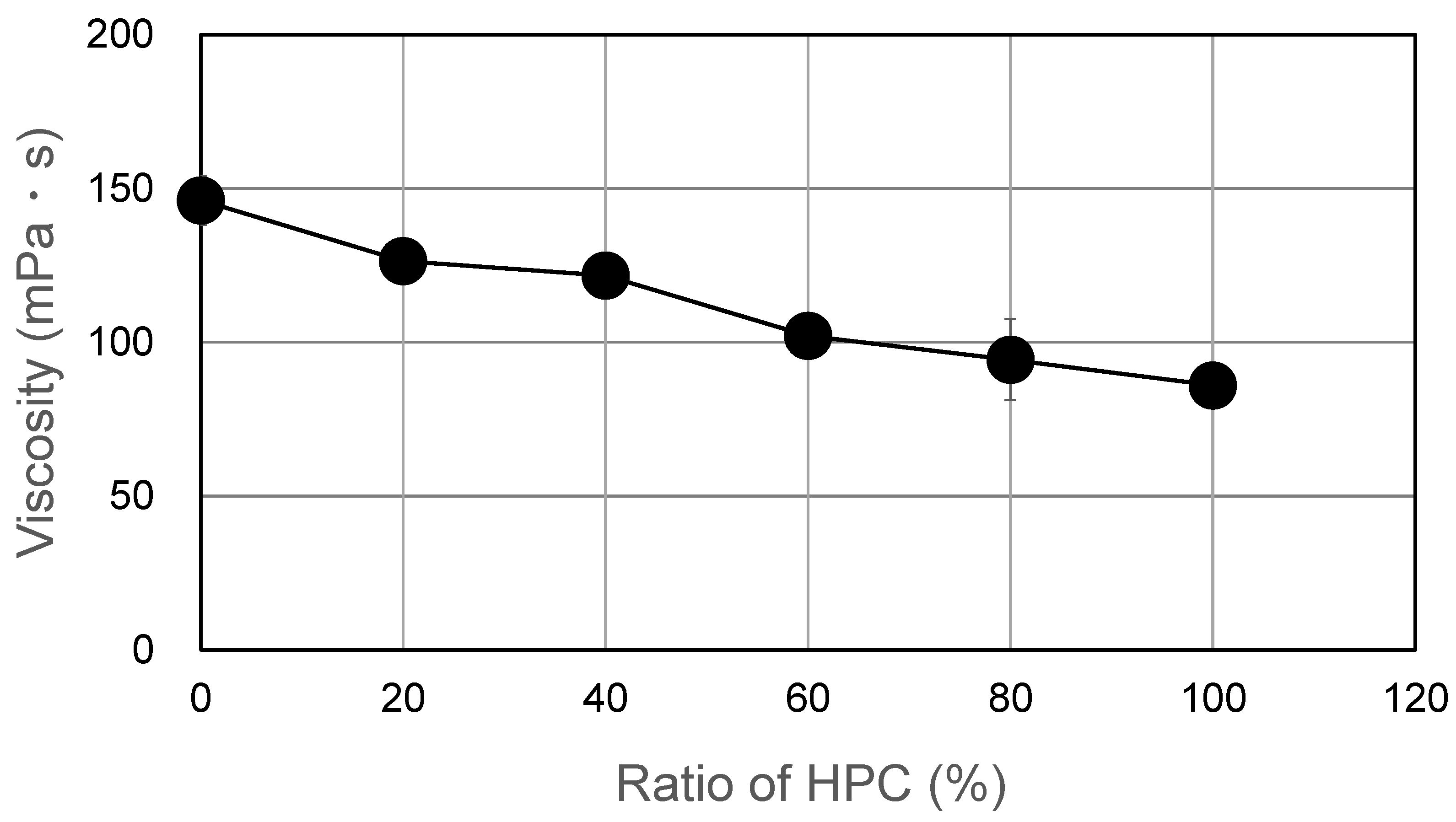
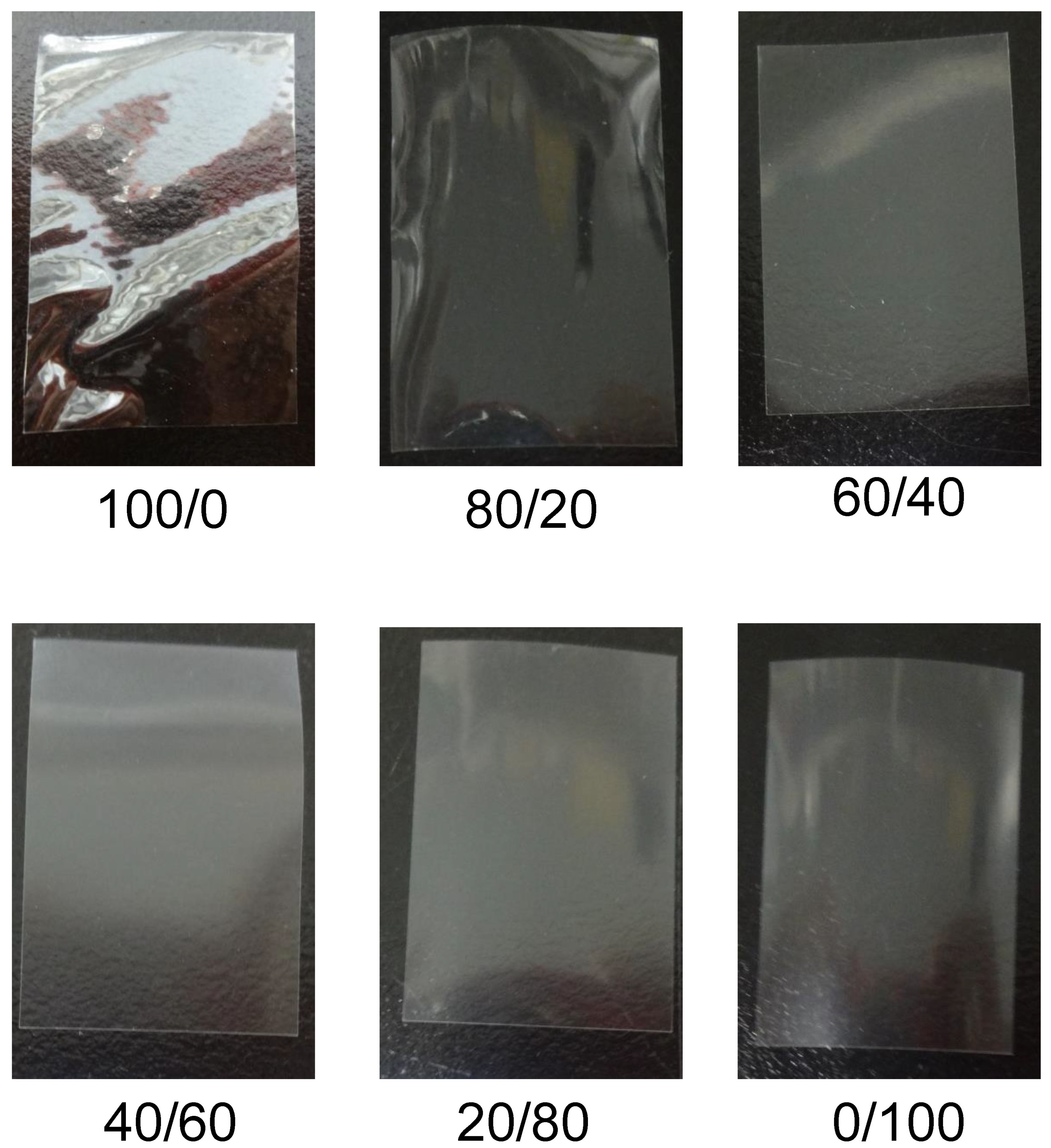
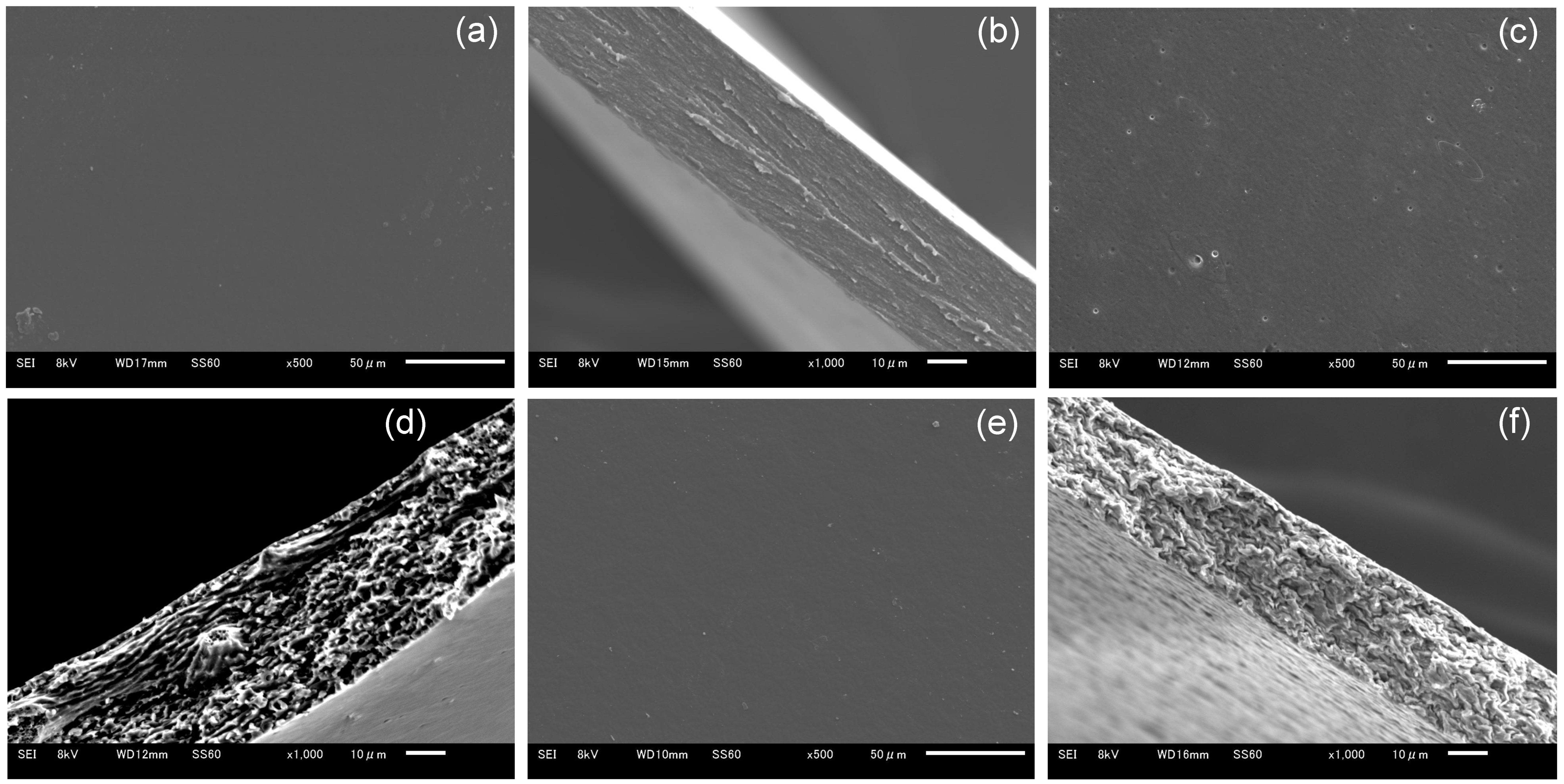

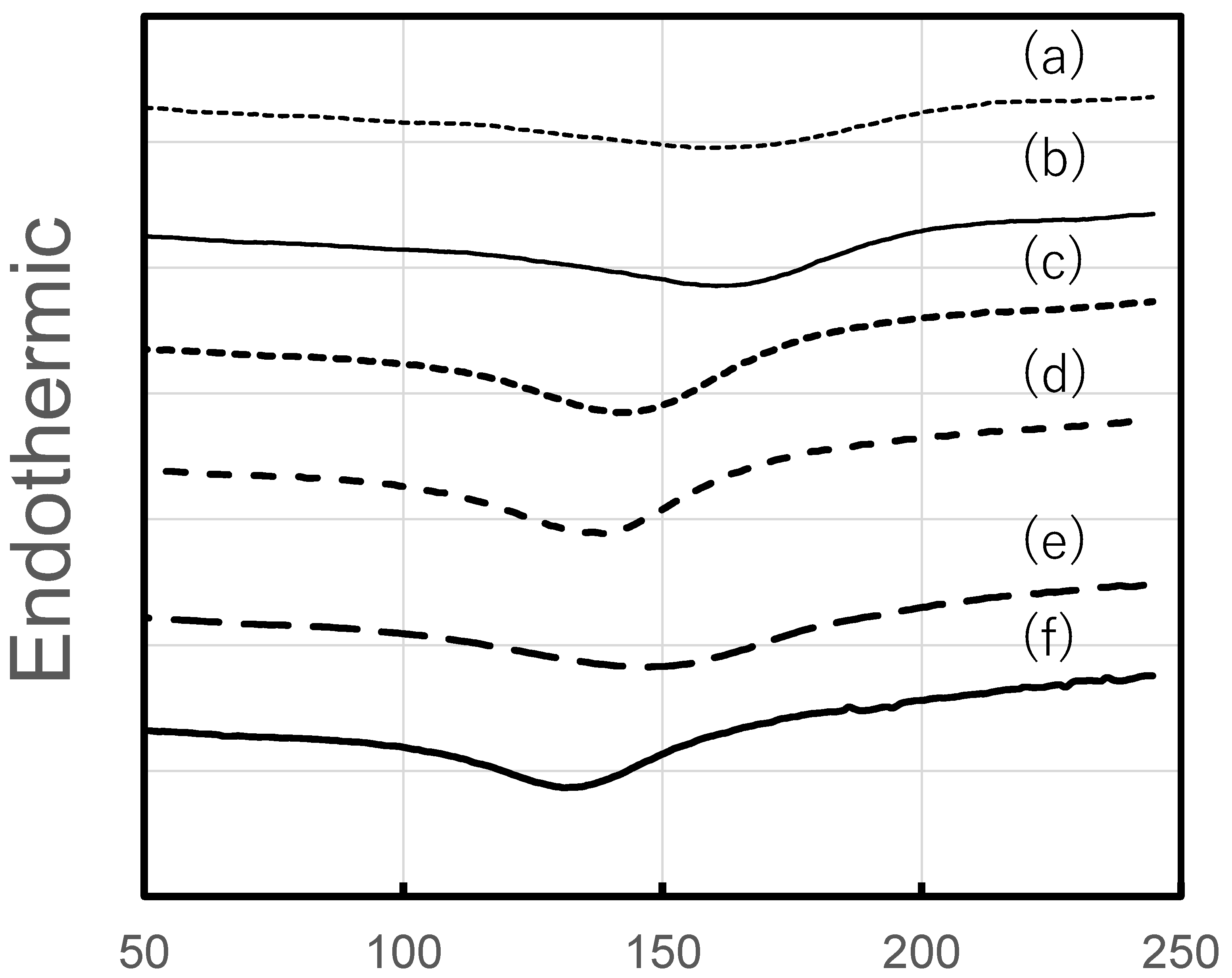
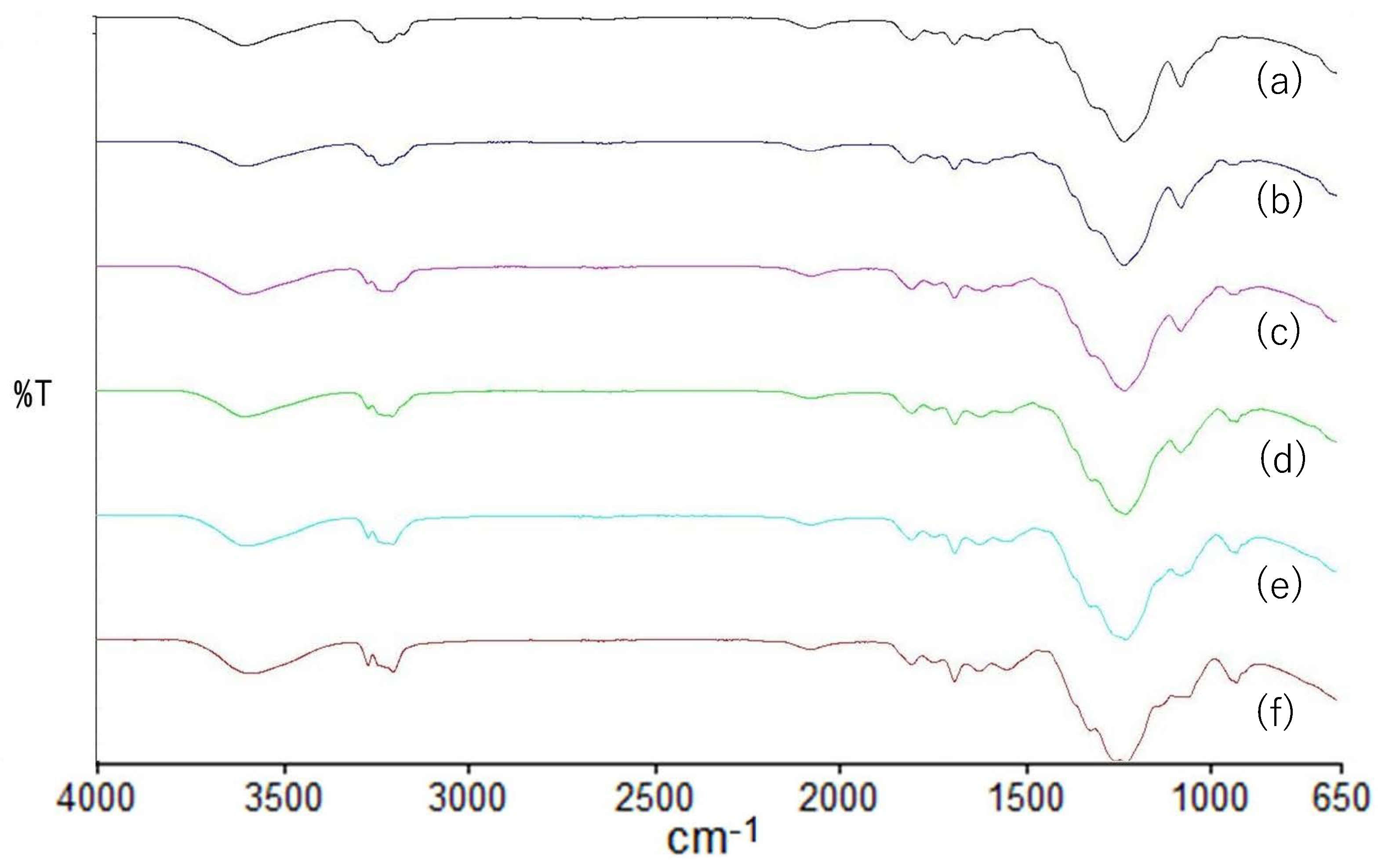
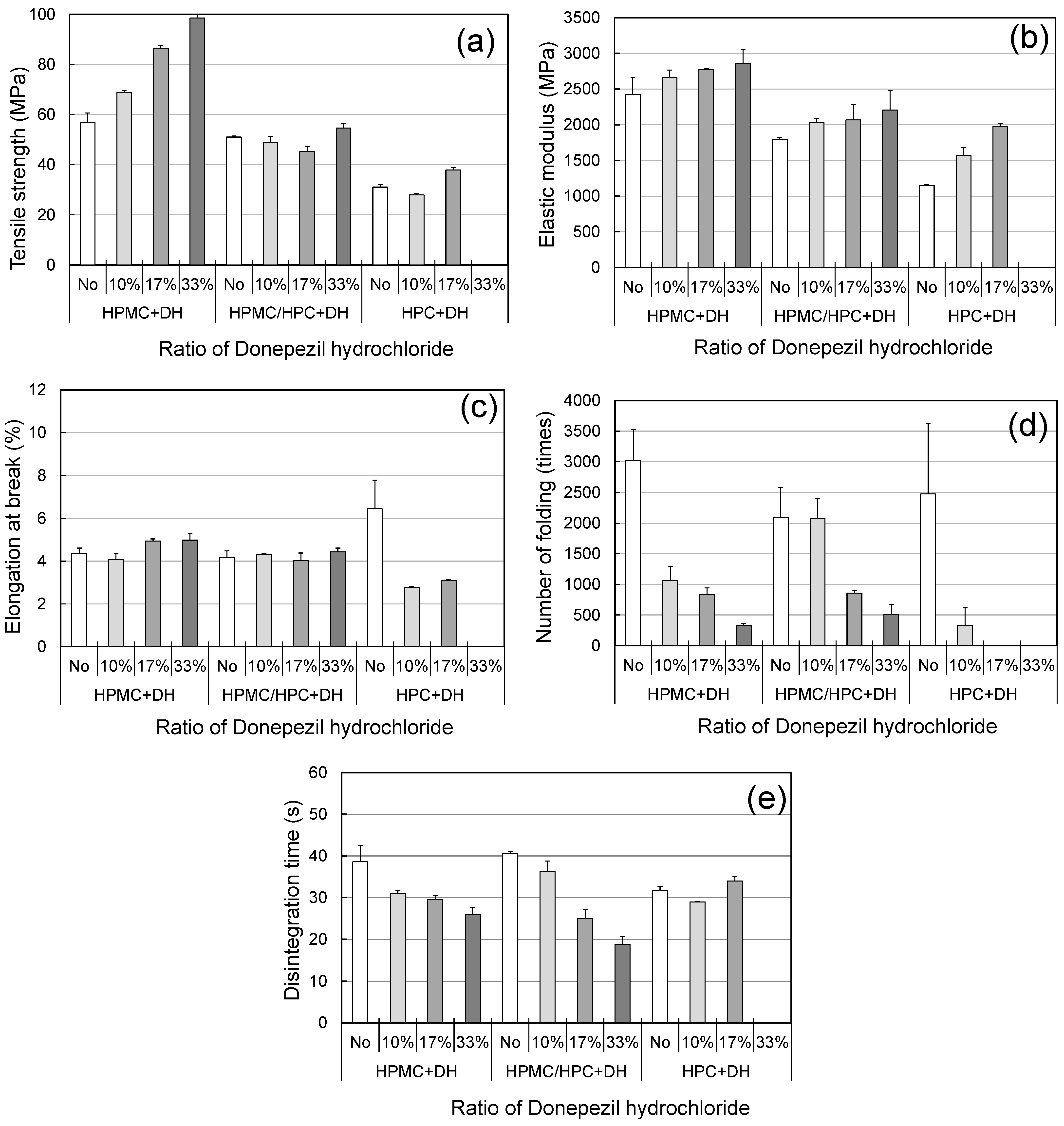

| Ingredient | HPMC | HPMC/HPC | HPC | HPMC/DH | HPMC/HPC/DH * | HPC/DH | ||||||||||
|---|---|---|---|---|---|---|---|---|---|---|---|---|---|---|---|---|
| HPMC | 100.0 | 90.0 | 80.0 | 60.0 | 40.0 | 20.0 | - | 90.0 | 83.3 | 66.7 | 72.0 | 66.7 | 53.3 | - | - | - |
| HPC | - | 10.0 | 20.0 | 40.0 | 60.0 | 80.0 | 100.0 | - | - | - | 18.0 | 16.7 | 13.3 | 90.0 | 83.3 | 66.7 |
| DH | - | - | - | - | - | - | - | 10.0 | 16.7 | 33.3 | 10.0 | 16.7 | 33.3 | 10.0 | 16.7 | 33.3 |
| Total (%) | 100.0 | 100.0 | 100.0 | 100.0 | 100.0 | 100.0 | 100.0 | 100.0 | 100.0 | 100.0 | 100.0 | 100.0 | 100.0 | 100.0 | 100.0 | 100.0 |
Disclaimer/Publisher’s Note: The statements, opinions and data contained in all publications are solely those of the individual author(s) and contributor(s) and not of MDPI and/or the editor(s). MDPI and/or the editor(s) disclaim responsibility for any injury to people or property resulting from any ideas, methods, instructions or products referred to in the content. |
© 2025 by the authors. Licensee MDPI, Basel, Switzerland. This article is an open access article distributed under the terms and conditions of the Creative Commons Attribution (CC BY) license (https://creativecommons.org/licenses/by/4.0/).
Share and Cite
Takeuchi, Y.; Hayakawa, F.; Takeuchi, H. Formulation Design of Orally Disintegrating Film Using Two Cellulose Derivatives as a Blend Polymer. Pharmaceutics 2025, 17, 84. https://doi.org/10.3390/pharmaceutics17010084
Takeuchi Y, Hayakawa F, Takeuchi H. Formulation Design of Orally Disintegrating Film Using Two Cellulose Derivatives as a Blend Polymer. Pharmaceutics. 2025; 17(1):84. https://doi.org/10.3390/pharmaceutics17010084
Chicago/Turabian StyleTakeuchi, Yoshiko, Fumika Hayakawa, and Hirofumi Takeuchi. 2025. "Formulation Design of Orally Disintegrating Film Using Two Cellulose Derivatives as a Blend Polymer" Pharmaceutics 17, no. 1: 84. https://doi.org/10.3390/pharmaceutics17010084
APA StyleTakeuchi, Y., Hayakawa, F., & Takeuchi, H. (2025). Formulation Design of Orally Disintegrating Film Using Two Cellulose Derivatives as a Blend Polymer. Pharmaceutics, 17(1), 84. https://doi.org/10.3390/pharmaceutics17010084







